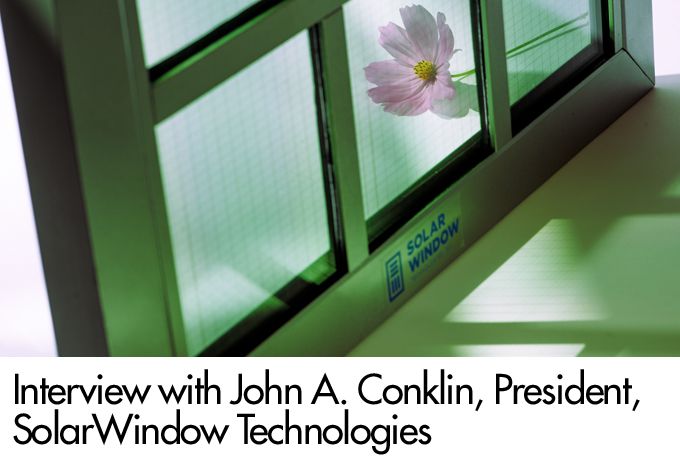We envision our technology to be part of the next-generation of skyscrapers and commercial buildings, and installed in buildings around the world, providing a source of clean, renewable energy to help meet the worlds growing energy demands.
John A. Conklin | SolarWindow
What is SolarWindow?
SolarWindow™ is the world’s first-of-its-kind transparent electricity-generating coating for glass and plastic. The company’s objective is to turn tall towers and skyscrapers into electricity-generating buildings by turning passive windows into active sources of renewable energy. Initially, SolarWindow™ technology is being developed for tall towers and skyscrapers, and large-area glass and BIPV applications in new construction, retrofit, and replacement windows. Residential products for new construction and replacement windows are also planned for development.
What makes SolarWindow work--what is the science behind the technology?
The original concept of SolarWindow Technologies’ electricity-generating coating was based on a nanosilicon photovoltaic solar cell technology. Early stage proof-of-concept research was based on integrating films of silicon nanoparticles on glass surfaces in order to convert solar energy into electricity, without losing significant transparency or requiring major changes in manufacturing infrastructure.
Over the years, the coatings evolved into the use of earth abundant, and organic polymer based chemicals and materials that form today’s SolarWindow™ transparent electricity-generating coatings. When applied to glass, flexible plastics, or other suitable substrates, this technology generates electricity and turns that surface into a source of renewable energy. Company engineers and scientists envision installing SolarWindow™ coatings on the vast areas of tinted glass surfaces on commercial buildings.
How can they be "solar" and transparent at the same time?
Our SolarWindow™ coatings are made up organic polymers and other transparent materials that, when combined, are referred to as an organic photovoltaic (OPV) device, which converts light energy into electricity. SolarWindow™ modules are created by applying our ultra-thin liquid layers on glass, plastics, or other suitable substrates, resulting in a transparent, electricity-generating coating.
What is the most popular application for the windows?
We believe that a significant market opportunity exists for our SolarWindow™ technology. The global flat glass market is estimated to be about $8.3 billion in 2016. The world demand for flat glass is forecast to rise 6.3 percent per year through 2016 to 8.3 billion square meters. Currently, 50 percent of U.S. electrical generation relies on coal, a fossil fuel; while 85 percent of U.S. greenhouse gas emissions result from energy-consuming activities supported by fossil fuels.
Our SolarWindow™ products are being developed to performance standards which give real estate developers, engineers, architects, building designers, and future customers financial, renewable energy, and environmental incentives.
We envision our technology to be part of the next-generation of skyscrapers and commercial buildings, and installed in buildings around the world, providing a source of clean, renewable energy to help meet the world’s growing energy demands.
How much do they cost relative to standard windows and how do the energy numbers justify the premium?
We are developing SolarWindow coatings to be applied to new construction, retrofit and replacement windows without adding too much additional cost to that of a typical window. SolarWindow™ modules would be installed by today’s installers, thus not adding an additional cost to the window installation. An additional cost would be incurred for an electrician for interconnection to the building electrical system. These costs, however, should be offset by the value SolarWindow™ modules provide in generating renewable energy, and the very short payback and return on investment. Our modeling shows that the financial payback for SolarWindow™ systems could be less than one year.
SolarWindow has achieved records in power and size that has been validated by the United States Department of Energy’s National Renewable Energy Laboratory (NREL). Our modules generate 50 times more energy than the competing rooftop modules when applied to a 50 story building.
How will your window technology help the environment?
Energy demand in the US and globally continues to increase, and there is more need for clean, renewable energy sources. US electricity demand is expected to grow 40% by 2032. Information from the US Department of Energy shows commercial buildings alone are using over one-third of all electricity produced in the US.
As a transparent electricity-generating coating, we see SolarWindow™ modules being applied to the vast acres of window glass in tall towers and skyscrapers to provide a source of renewable electricity and offset the buildings’ energy needs in this untapped market.
The application of SolarWindow™ modules installed in tall towers and skyscrapers also addresses the need to produce renewable energy for a structure that has limited rooftop space.
The ability to reduce greenhouse gases such as carbon dioxide provides a health and environmental benefit. Carbon dioxide traps heat, contributing to global warming. Think of the benefit that SolarWindow™ modules installed on the vast acres of glass on tall towers and skyscrapers around the world may provide in offsetting carbon dioxide, helping to manage global warming, and contributing to reducing air emission pollutants that are harmful to human health.
How much power would SolarWindow offset?
SolarWindow Technologies proprietary Power and Financial Model (Model) shows SolarWindow™ transparent electricity-generating coatings may offset approximately 30 percent to 50 percent of a 50-story building energy demands. Although this is a modeled estimate, the amount of energy may be slightly more, or less, depending on:
- Building footprint (street footprint),
- Building type,
- Geographic location,
- Climate zone,
- Energy demand, and
- Irradiance (amount of peak sun hours per day).
Several other variables must be considered when evaluating the SolarWindow™ Modules OPEX reduction.
Has the efficiency of SolarWindow been independently tested?
SolarWindow™ high performance modules’ power, performance, and efficiency has been independently tested by the United States Department of Energy's, National Renewable Energy Laboratory (NREL).
How do you foresee the next 5 or 10 years evolving for SolarWindow?
The company’s Go-to-Market (GTM) strategy is based on providing a renewable energy solution to the energy demands of tall towers and skyscrapers. An estimated 500 million square feet of glass is installed on these target buildings each year in the United States alone. Information from the US Department of Energy shows commercial buildings are using more than one-third of all electricity produced in the U.S.
SolarWindow™ transparent electricity-generating coatings offer tall towers and skyscrapers a way of generating renewable energy where energy demand is extremely high, and the cost of real estate and other factors render surface mount solar and other renewables, impractical. Building developers and owners, and architects are searching for innovative ways to reduce energy use while offsetting energy demand. SolarWindow™ modules are being developed to provide renewable energy with a quick return on investment.
Moving forward, we have identified numerous product applications for our liquid coatings that are able to generate electricity on both glass and flexible surfaces while remaining transparent. You can expect to hear more about these product plans in the upcoming months. Meanwhile, the skyscraper and tall tower segment is our immediate target market.

John A. Conklin brings to SolarWindow Technologies, Inc. 30 years of industrial, commercial, renewable and alternative energy experience, having provided technical and business consulting services to more than 50 technology, manufacturing, and industrial process companies. Mr. Conklin’s client-companies have ranged from start-ups to Fortune 500 corporations, including IBM, Lockheed Martin, Frito-Lay, and TDI Power, Inc., a global manufacturer of power systems. Mr. Conklin possesses industrial process, environmental systems design, testing, and analytical experience, which has resulted in cost savings ranging from 10-25% for numerous clients in the surface coatings industry. Surface coatings are key to the development of SolarWindow™, which makes use of special coatings that allow for the generation and movement of electricity on see-through glass. Mr. Conklin holds a North American Board of Certified Energy Practitioners (NABCEP) Level I Certificate, globally-recognized as North America’s “gold standard” agency for photovoltaic and solar thermal installation certification. He routinely attends NABCEP certified training programs throughout the Northeastern United States.
The content & opinions in this article are the author’s and do not necessarily represent the views of AltEnergyMag
Comments (0)
This post does not have any comments. Be the first to leave a comment below.
Featured Product


